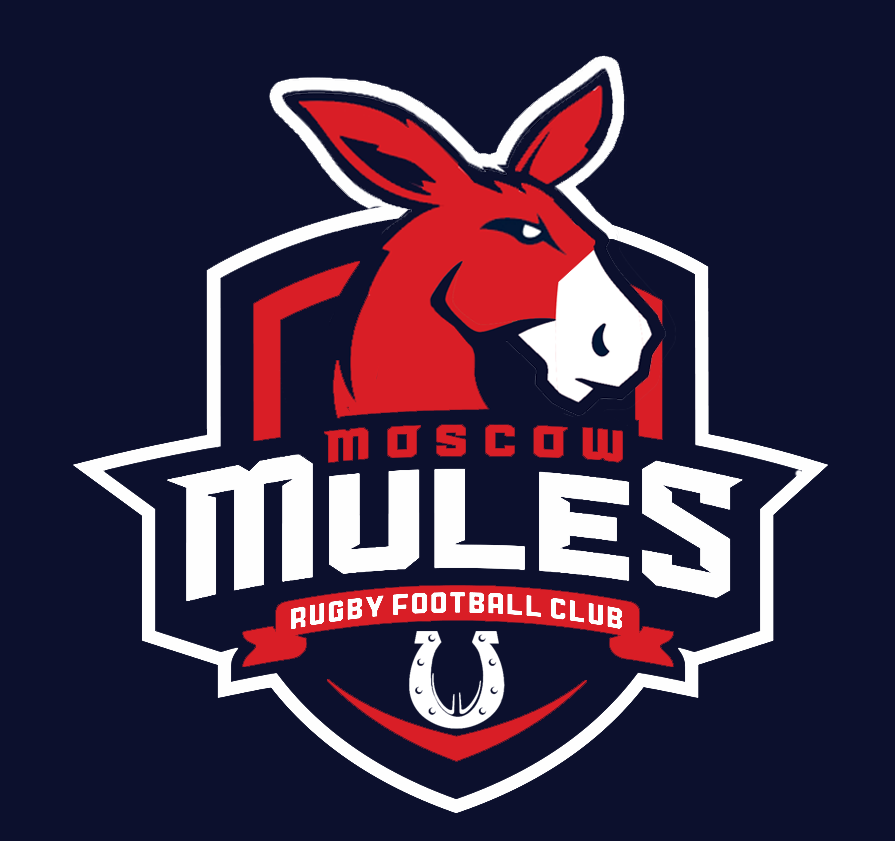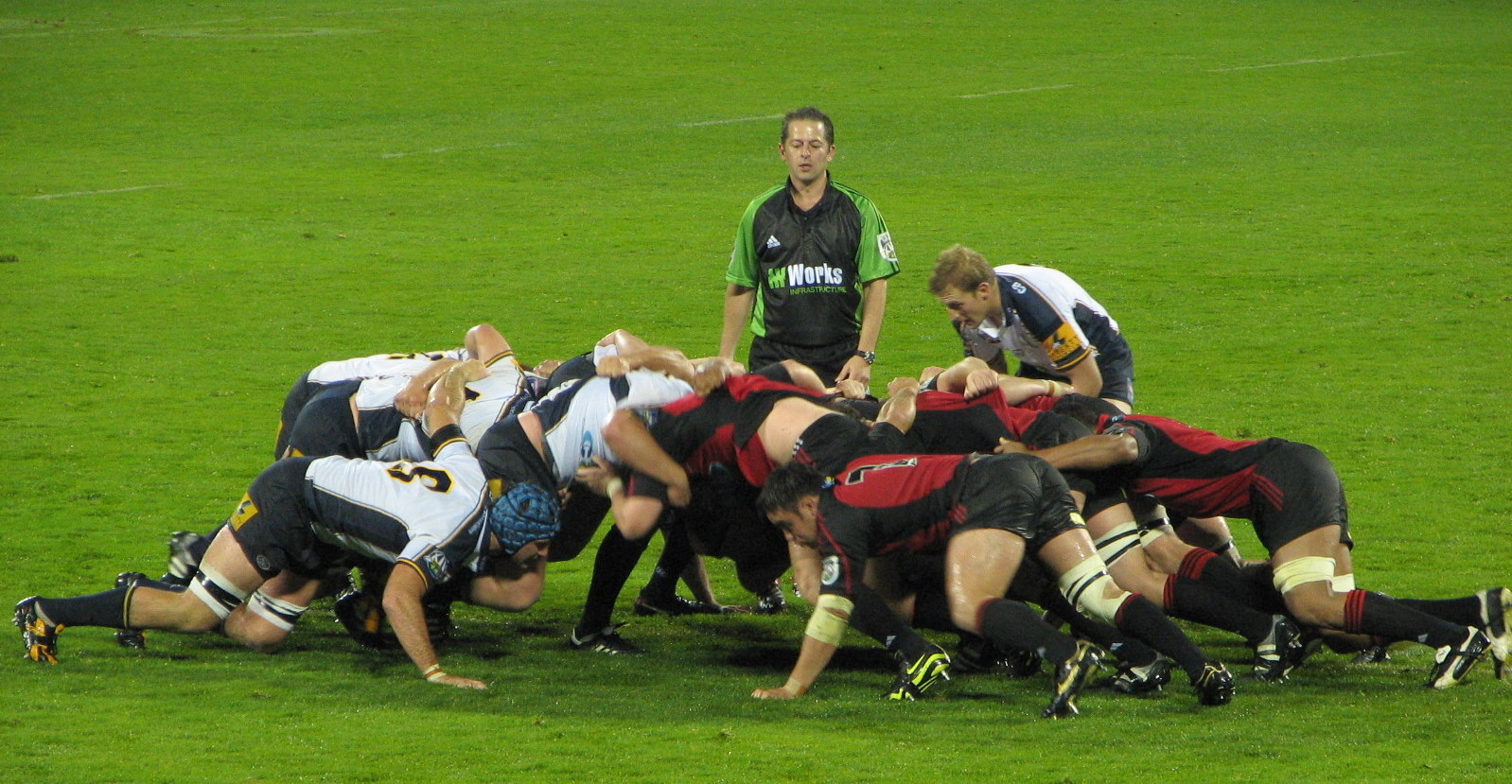Play
Like football, an opponent may tackle the ball carrier at any time. However, blocking for the ball carrier is not allowed and tacklers must wrap the ball carrier with their arms. The ball carrier may run or kick the ball forward but can only pass the ball laterally or back. The game is free flowing and play is only stopped if someone scores, breaks a law, or propels the ball out of bounds ("in touch"). Similar to the off-sides rule in soccer, a rugby player is off-side anytime that player is in front of the team-mate that has control of the ball or the team-mate that last played the ball. However, being off-side is only illegal if the player who is off-side attempts to participate in the game at that time.
Teams
Traditional rugby consists of 15 players on each side. Players in a team are divided into eight forwards and seven backs. Forwards are generally bigger and stronger, and take part in the scrum and lineout, while backs are generally smaller but faster, more agile and often the main point scorers for the team.
Duration
Traditional rugby consists of 40 minute halves and a 10 minute half time. Duration may change depending on circumstances.
Field
Rugby is played on a field 144 meters in length including two 22 meter try zones and 70 meters wide.
Equipment
To play rugby, all you need is a rugby ball! Most players also wear a pair of boots (cleats) and a mouth guard.
Scoring
There are four ways to score points in a rugby game.
Drop Goal – During play a team may drop the ball on the ground and kick it over the goal, this is called a drop goal. This is worth 3 points.
Try – Once over an opponent’s goal line (their ‘try zone’) the ball is touched to the ground. This is worth 5 points.
Conversion – Upon scoring a try the scoring team gets an attempt to kick the ball over the crossbar and through the posts of the rugby uprights. This is worth 2 points.
Penalty – If the opposition commits a penalty, a team can choose to kick at the goal. A penalty kick is worth 3 points.
Tackling
Rugby is a continuous, full contact sport. What this means is that once a tackle is made play continues. A tackle occurs when the ball carrier is taken to the ground by a member of the opposition. Once tackled, a ball carrier must release the ball. Once a player makes a tackle they must roll away from the play.
Ruck
Once a player is tackled to the ground a ruck is formed when one or more players from each team close around the ball. The ball then emerges and play continues.
Maul
When the ball carrier is held up by a member of the opposition and by a member on his/her own team it is called a maul. The ball can either be removed from the maul or taken to the ground which then forms a ruck.
Scrum
A scrum is used to restart play after a minor infringement occurs (i.e. forward pass). The scrum consists of eight of the 15 players, called forwards. These eight players bind together and come head to head with the eight players of the opposition. The ball is thrown into the middle of the scrum on the ground and the players work with their feet to hook the ball behind them making it available to play. The ball is then collected by the scrumhalf and passed out to the back line.
Lineout
When the ball goes out of bounds play is restarted with a lineout. Two lines are formed with opposing teams at least 5m from the sideline. The ball is thrown into the tunnel between the lines. Teams will lift players to contest for the ball.
Positions:
The first eight players, known as forwards or the pack, play in the scrum. The remaining seven players play as the backs.
Props - No 1 & 3
(Also known as Prop forward, tighthead, loosehead)
The two prop's primary responsibilities are to win scrums, lineouts and to hit the rucks and mauls. Generally one of the biggest and stockiest players on the pitch, props, along with the hooker make up the front row of the scrum and tend to lift the lock in lineouts.
Hooker - NO 2
(Also known as Hook, rake)
His primary responsibilities are to win scrums by hooking the ball back, (typically) throwing into the lineouts and being very active at the rucks and mauls.
Locks - No 4 & 5
(Also known as Second row, lock forward)
You have two Lock forwards. These players tend to be the tallest players on the pitch and are as a result vital at lineout time. They act in similar fashion to the props in that they are sturdy in defense and hard charging on offense.
Flankers - No 6 & 7
(Also known as Wing forward, breakaway, flank, flank forward, loose forward, blind side, open side)
The two Flankers fit on either side of the scrum helping push the props, but should always be ready to break off immediately from the scrum to chase down the ball. The Flanker is looking to be as near the ball as he can at all times and serve as a link between the forwards and backs on offense and as a roving defender when not in possession.
Number EIGHT - No 8
(Also known as Eight, eightman, eighthman, loose forward)
The Number 8 sits at the back of the pack (literally the eighth man to fit into the scrum) and like Flankers will be looking for loose balls and then supporting his backs when on the attack.
Scrum Half - NO 9
(Also known as Inside half, half-back, scrum off, scrummie)
A key position on the pitch. The scrum half is responsible for feeding the ball into the scrum on offense or guarding and pressuring the opposition scrum half on defense. The Scrum Half also typically passes the ball from scrums to his fly half or other backs.
Fly-Half - No 10
(Also known as Outside half, out half, stand-off, stand-off half, five-eighth, first five-eighth, first five, fly, pivot)
The key decision-maker amongst the backs whose role is to distribute the ball. Fly Halves should generally be able to pass very well and be able to kick well as they will be called upon to kick the ball and relieve pressure given they typically receive the ball first amongst the backs.
Outside Center - NO 12
(Also known as Centre, centre three-quarter, second center)
Typically very good try scorers and ball carriers, the Outside Center is the last man before the wingers. Typically the Outside Center is used to set up the Winger, but should attack any opportunity in the defensive line first and foremost before passing to the winger.
Inside Center - NO 13
(Also known as Second five-eighth, first centre, second five or center)
The Inside Center tends to perform a lot of the defensive work for the backs and is integral to getting the ball out wide to the wingers. The Inside Center is typically the largest back if he is being used for lots of crash ball or is one of the most skilled if he is being utilized more as a second Fly-Half.
Wingers - No 11 & 14
Winger (Wing, wingman, wing three-quarter)
Out on his own on the side of the field, the Winger may not get the ball as often as other backs but he is designated as the finisher and should look to attack any space opened up for him and score tries. Wingers are usually the fastest players on the field given the nature of their job.
NO 15 - FULLBACK
(Also known as Custodian, sweeper, number 15)
The Fullback is the last line of defense as he normally hangs back in defense to cover opposition kicks and as such should have superb tackling skills. A good fullback also needs excellent field vision to pick the right spots to attack on offense when he sees an opening. He will need to be able to kick well from deep to help clear the ball and relieve pressure when the opposition are attacking

